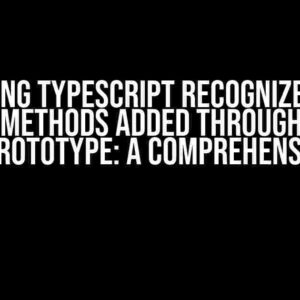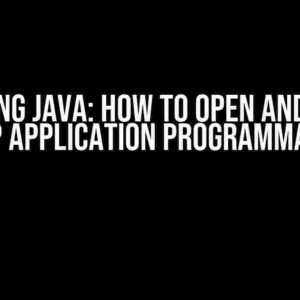As Java developers, we’ve all been there – stuck in the depths of a debugging session, scratching our heads over why our code won’t behave as expected. One of the most mind-boggling conundrums is the conflicting JVM specifications between what can be verified at runtime and what is debuggable when it comes to local variables. In this article, we’ll delve into the depths of this puzzle, unraveling the mystery and providing clear, actionable guidance to help you navigate these treacherous waters.
The JVM Specification Conundrum
The Java Virtual Machine (JVM) is the lifeblood of Java development, responsible for executing our code and ensuring it adheres to the language’s specifications. However, when it comes to local variables, the JVM’s specifications can be seemingly contradictory, leading to frustration and confusion.
On one hand, the JVM is required to verify the correctness of our code at runtime, ensuring that it conforms to the language’s rules and semantics. This is where the term “verifiable” comes into play – the JVM checks our code against the defined specifications to ensure it’s valid and executable.
On the other hand, when we’re debugging our code, we expect the JVM to provide us with meaningful information about the state of our program, including the values of local variables. This is where the term “debuggable” comes into play – we want the JVM to give us insight into what’s happening under the hood, so we can identify and fix issues.
The Conflict: Verifiable vs. Debuggable
Here’s where things get tricky. The JVM’s verifiable and debuggable specifications can sometimes conflict, leading to unexpected behavior or unexpected errors. This conflict arises from the fact that the JVM’s verification process and debugging mechanisms operate under different rules and assumptions.
At runtime, the JVM’s verification process focuses on ensuring that our code adheres to the language’s specifications, ignoring any unnecessary information that might slow down execution. This means that some local variables might not be accessible or debuggable, as they’re optimized away or rewritten during the compilation process.
However, when we’re debugging our code, we expect the JVM to provide us with detailed information about the state of our program, including the values of local variables. This can lead to a disconnect between what we expect to see during debugging and what the JVM actually provides.
Understanding the JVM’s Optimization Process
To better understand the conflict between verifiable and debuggable specifications, let’s take a closer look at the JVM’s optimization process.
During compilation, the Java compiler (javac) performs several optimizations to improve the performance and efficiency of our code. One of these optimizations is the elimination of unnecessary local variables, which can be rewritten or removed if they’re not used elsewhere in the code.
public class Example {
public static void main(String[] args) {
int x = 10;
int y = x + 5;
System.out.println(y);
}
}
In this example, the local variable `x` is optimized away, as it’s not used anywhere else in the code. During runtime, the JVM will only see the result of the expression `x + 5`, which is stored in the `y` variable.
This optimization process can lead to unexpected behavior during debugging, as the JVM might not provide access to the original local variable `x`, even though it’s declared in the code.
Implications for Debugging
So, what does this mean for debugging? When we’re stepping through our code, we expect to see the values of local variables, but the JVM’s optimization process can make this challenging.
In some cases, the JVM might not provide access to certain local variables, or might display incorrect or outdated values. This can be frustrating, especially when we’re trying to identify the root cause of an issue.
To mitigate this issue, we can use the `-g` flag during compilation, which tells the compiler to include debugging information in the generated bytecode. This can help the JVM provide more accurate and detailed information during debugging.
javac -g Example.java
Alternatively, we can use a Java debugger like Eclipse or IntelliJ IDEA, which provide advanced debugging features and can help us navigate the complexities of the JVM’s optimization process.
Best Practices for Debugging Local Variables
So, what can we do to ensure that we’re getting the most out of our debugging sessions? Here are some best practices to keep in mind:
- Use the `-g` flag during compilation: This ensures that the compiler includes debugging information in the generated bytecode, making it easier for the JVM to provide accurate and detailed information during debugging.
- Use a Java debugger: Tools like Eclipse or IntelliJ IDEA provide advanced debugging features, including the ability to inspect local variables and set breakpoints.
- Minimize optimization: During debugging, it’s a good idea to minimize optimization by using the `-O0` flag during compilation. This can help ensure that the JVM provides more accurate and detailed information.
- Use System.out.println() for debugging: While not the most elegant solution, using `System.out.println()` statements can help us inspect the values of local variables during runtime.
- Understand the JVM’s optimization process: By understanding how the JVM optimizes our code, we can better anticipate and work around any issues that might arise during debugging.
Conclusion
In conclusion, the conflicting JVM specifications between verifiable runtime and debuggable local variables can be a complex and challenging issue. However, by understanding the JVM’s optimization process and following best practices for debugging, we can navigate these treacherous waters and ensure that our code is reliable, efficient, and debuggable.
Remember, the JVM’s specifications are in place to ensure the correctness and safety of our code, but they can sometimes lead to unexpected behavior during debugging. By being aware of these limitations and working within them, we can write better, more maintainable code that’s easier to debug and optimize.
So, the next time you’re stuck in a debugging session, remember to take a step back, breathe, and think about the JVM’s specifications. With patience, persistence, and a solid understanding of the JVM’s optimization process, you’ll be well on your way to unraveling even the most mysterious of debugging conundrums.
| Best Practice | Description |
|---|---|
| Use the `-g` flag during compilation | Includes debugging information in the generated bytecode |
| Use a Java debugger | Provides advanced debugging features, including inspection of local variables |
| Minimize optimization | Ensures more accurate and detailed information during debugging |
| Use System.out.println() for debugging | Helps inspect the values of local variables during runtime |
| Understand the JVM’s optimization process | Anticipate and work around issues that might arise during debugging |
By following these best practices and understanding the JVM’s specifications, you’ll be well-equipped to tackle even the most challenging debugging tasks. Happy coding!
Frequently Asked Question
In the realm of Java Virtual Machine (JVM) specifications, there lies a fascinating conundrum. What happens when the code that can be verified to run clashes with what can be debugged in terms of local variables? Let’s dive into the FAQs to unravel the mystery!
Q1: What’s the conflict between JVM specs and local variables?
The conflict arises when the JVM specification allows for a certain code to be verified and run, but the same code cannot be debugged in terms of local variables. This discrepancy can lead to confusion and errors during development.
Q2: Is this conflict due to a limitation in the JVM or the debugger?
The limitations lie in the JVM specification itself. The JVM is designed to verify and run code, whereas debuggers are separate tools that interact with the JVM to provide debugging capabilities. The conflict arises when the debugger’s capabilities clash with the JVM’s verification process.
Q3: Can this conflict be resolved, or is it a fundamental limitation?
While it’s challenging to eliminate the conflict entirely, some workarounds and improvements can be made to minimize the discrepancies. For instance, debugger developers can optimize their tools to better handle JVM limitations, and the JVM specification can be refined to provide more debugging-friendly features.
Q4: Are there any specific scenarios where this conflict arises?
The conflict often surfaces when dealing with complex or optimized code, such as code with inline caching, dead code elimination, or other compiler optimizations. In these scenarios, the JVM may verify and run the code, but the debugger may struggle to provide meaningful information about local variables.
Q5: What can developers do to mitigate the effects of this conflict?
Developers can take steps to simplify their code, avoid excessive compiler optimizations, and use debugging-friendly tools. Additionally, they can stay up-to-date with the latest JVM and debugger developments, which often include improvements to address these conflicts.






